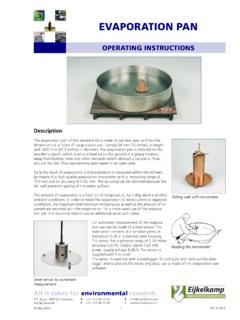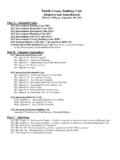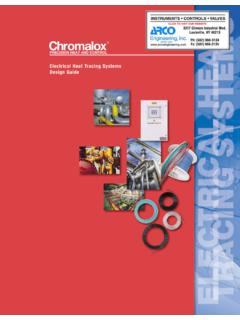Transcription of Geography Enquiries for KS3 Pupil sheet 9
1 Geography Enquiries for KS3 Pupil sheet 9. Drawing a cross-section A cross-section is a slice through a particular feature. 1 Decide where you want the cross-section line to Ax River be. To draw the shape of a river valley, the line is best drawn to connect the highest point on either side of the valley, at right-angles to the river. xB. 2 Put the straight edge of a piece of scrap paper along your cross-section line. Mark the beginning v v and end of the cross-section, and write down the A B. grid references. (301462) (335447). 3 Go along the cross-section line, making a mark every time a contour line goes under the paper. 250. 220. 200. 200. 240. 250. Add any height numbers you see. Also mark the A B. River Road position of any main features, eg the river or roads. 4 On graph paper, draw a frame for your cross- section. The length along the bottom should be 300. the same as your cross-section line.
2 The scale on 200. the side axis should be in 10 m intervals up to the 100. maximum height in your cross-section. 0. A B. 5 Put your piece of scrap paper along the bottom of the frame and mark on a dot for each contour line 300. in the correct place. The distance along the 200. bottom should be the same as on the scrap paper, and the distance up the side of the frame should 100. correspond to the height of the contour line. If you don't have a number for a particular line, count up 0. A B. or down from one you do have. Look out for places where the same contour line crosses the paper more than once. Remember there is a gap of 10 m between contour lines, 100 m and 50 m Height (cm). lines are shown in bold and the tops of height Road 300. River numbers are towards the top of the slope. 6 Join the dots with a smooth line and check back to 200. the map to make sure your cross-section looks 100.
3 Sensible. Draw arrows and label important features, eg the river or steep valley sides. 0. A B. (301462) (335447). Cross-section of the River Tarn Valley Pearson Publishing, Chesterton Mill, French's Road, Cambridge CB4 3NP 25. Geography Enquiries for KS3 Pupil sheet 11. Microclimate Enquiry: Question sheet The conclusion is a very important part of an enquiry write up. You should try to sum up what you found out about the school microclimate from your fieldwork. You could also try to explain why the results were like that. These questions may help you with your conclusion. Your teacher may tell you which ones to answer, or if not, you can choose your own. You don't have to use all of them! 1 What was the weather like in the general area round your school? 2 a Choose two different places where you took measurements. b Write down where each place was. c Say what the weather was like at each place.
4 (Try to back up your answer with figures from your fieldwork.). d Say how the weather at the two places was similar and how it was different. e Try to explain any differences. 3 If you look at your results, you may see a pattern. For example, It is hotter on the east of the school than on the west side' or The average windspeed was 8 mph near the building but 14. mph on the school field'. Write down one or more patterns you can see in your results. 4 Choose one of the patterns you have written down and try to explain why the results might be like that. Think about the effects of the building, where the sun was at the time, etc. 5 Do you have any comments about the way you obtained the data? Is there anything which you would try to improve next time? 6 For the case of your school, how have physical and human factors combined to create the microclimate? 7 Have you ever experienced any other microclimates (for example on a beach or in a wood)?
5 Choose one and write about what it was like. Try to explain why it was like that. How does it compare to your school's microclimate? 8 Can you think of any instances where microclimates can be useful to people? Describe an example and explain why it's useful. Pearson Publishing, Chesterton Mill, French's Road, Cambridge CB4 3NP 30. Geography Enquiries for KS3 Pupil sheet 15. Rainforests Enquiry: Questions Work through the five sections below in any order. You can also write down other things you find interesting about the rainforest. What creatures live in the rainforest? Draw and label pictures of two of these creatures. What is the forest like? Choose from: Find a picture of a rainforest. What does it a bird look like? an animal What is the weather like in the rainforest? an insect or reptile Draw a picture of a rainforest tree. Label it to a fish. show how it copes with the climate and soil.
6 Where are the rainforests? Find a world map which shows where rainforests are. Name three countries which have rainforests Which parts of the world have rainforests? (eg North, South). Why are rainforests only in some parts of the world? How do people live in the rainforest? Find a picture of someone's house in a rainforest and draw it. Why do you think it is like that? How do people who live in the forest spend their time? What do you think would be good and bad about living in the forest? How are people changing the rainforest? What can the rainforest be used for? (Name at least three things). How can people harm the forest? Why is the rainforest worth protecting? Pearson Publishing, Chesterton Mill, French's Road, Cambridge CB4 3NP 37. Geography Enquiries for KS3 Pupil sheet 27. Environmental Issues: Map of Keswick A591. A66. Lonscale Fell Hills A. A66. Keswick B. Hills Derwent Water Hills A591.
7 Key Hills Town A' roads Proposed A B. Lake Woods Minor roads sites Pearson Publishing, Chesterton Mill, French's Road, Cambridge CB4 3NP 61.














